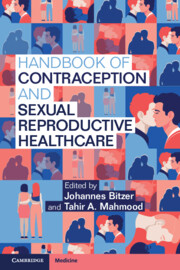Book contents
- Handbook of Contraception and Sexual Reproductive Healthcare
- Handbook of Contraception and Sexual Reproductive Healthcare
- Copyright page
- Dedication
- Contents
- About the Authors
- Contributors
- Preface
- Section 1 Scientific Basis of Contraception and Family Planning
- Section 2 Methods of Contraception
- Chapter 6 Combined Hormonal Contraceptives
- Chapter 7 Progestogen-Only Contraceptives
- Chapter 8 Depot Hormonal Contraceptive Devices
- Chapter 9 Non-Hormonal Intra-Uterine Device
- Chapter 10 Barrier Methods: Male and Female
- Chapter 11 Fertility Awareness-Based Methods
- Chapter 12 Female Sterilization
- Chapter 13 Male Sterilization
- Chapter 14 Male Hormonal Contraception
- Chapter 15 Emergency Contraception
- Section 3 Contraception and Medical Conditions
- Section 4 Subfertility
- Section 5 Termination of Pregnancy
- Section 6 Sexually Transmitted Diseases and Other Vulvovaginal and Urogenital Infections
- Section 7 Sexual Health
- Section 8 Cervical Cancer Screening
- Section 9 Standards of Care for Sexual and Reproductive Healthcare Services
- Index
- References
Chapter 10 - Barrier Methods: Male and Female
from Section 2 - Methods of Contraception
Published online by Cambridge University Press: 25 March 2022
- Handbook of Contraception and Sexual Reproductive Healthcare
- Handbook of Contraception and Sexual Reproductive Healthcare
- Copyright page
- Dedication
- Contents
- About the Authors
- Contributors
- Preface
- Section 1 Scientific Basis of Contraception and Family Planning
- Section 2 Methods of Contraception
- Chapter 6 Combined Hormonal Contraceptives
- Chapter 7 Progestogen-Only Contraceptives
- Chapter 8 Depot Hormonal Contraceptive Devices
- Chapter 9 Non-Hormonal Intra-Uterine Device
- Chapter 10 Barrier Methods: Male and Female
- Chapter 11 Fertility Awareness-Based Methods
- Chapter 12 Female Sterilization
- Chapter 13 Male Sterilization
- Chapter 14 Male Hormonal Contraception
- Chapter 15 Emergency Contraception
- Section 3 Contraception and Medical Conditions
- Section 4 Subfertility
- Section 5 Termination of Pregnancy
- Section 6 Sexually Transmitted Diseases and Other Vulvovaginal and Urogenital Infections
- Section 7 Sexual Health
- Section 8 Cervical Cancer Screening
- Section 9 Standards of Care for Sexual and Reproductive Healthcare Services
- Index
- References
Summary
Composition, types, mechanism of action, efficacy, effectiveness, health risks, benefits, usage and follow up of non-hormonal methods are explored
- Type
- Chapter
- Information
- Publisher: Cambridge University PressPrint publication year: 2022

